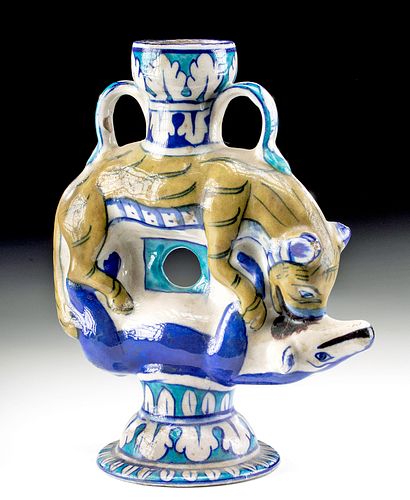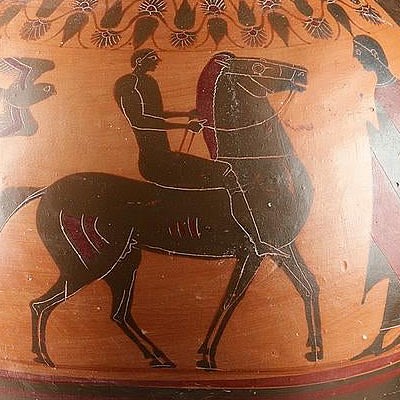19th C. Indian Mughal Multan Pottery Vase
Lot 112
About Seller
Artemis Gallery
686 S Taylor Ave, Ste 106
Louisville, CO 80027
United States
Selling antiquities, ancient and ethnographic art online since 1993, Artemis Gallery specializes in Classical Antiquities (Egyptian, Greek, Roman, Near Eastern), Asian, Pre-Columbian, African / Tribal / Oceanographic art. Our extensive inventory includes pottery, stone, metal, wood, glass and textil...Read more
Categories
Estimate:
$2,500 - $5,000
Absentee vs Live bid
Two ways to bid:
- Leave a max absentee bid and the platform will bid on your behalf up to your maximum bid during the live auction.
- Bid live during the auction and your bids will be submitted real-time to the auctioneer.
Bid Increments
| Price | Bid Increment |
|---|---|
| $0 | $25 |
| $300 | $50 |
| $1,000 | $100 |
| $2,000 | $250 |
| $5,000 | $500 |
| $10,000 | $1,000 |
| $20,000 | $2,500 |
| $50,000 | $5,000 |
| $100,000 | $10,000 |
| $200,000 | $20,000 |
About Auction
By Artemis Gallery
Jun 4, 2020
Set Reminder
2020-06-04 10:00:00
2020-06-04 10:00:00
America/New_York
Bidsquare
Bidsquare : Exceptional Antiquities, Asian, Ethnographic
https://www.bidsquare.com/auctions/artemis-gallery/exceptional-antiquities-asian-ethnographic-5185
An important one-day auction featuring museum-worthy examples of Egyptian, Greek, Roman, Etruscan, Near Eastern, Far East / Asian, Pre-Columbian, African / Tribal, Oceanic, Native American, Spanish Colonial, Russian, Fossils, Ancient Jewelry, Fine Art, so much more! Artemis Gallery info@artemisgallery.com
An important one-day auction featuring museum-worthy examples of Egyptian, Greek, Roman, Etruscan, Near Eastern, Far East / Asian, Pre-Columbian, African / Tribal, Oceanic, Native American, Spanish Colonial, Russian, Fossils, Ancient Jewelry, Fine Art, so much more! Artemis Gallery info@artemisgallery.com
- Lot Description
South Asia, India, southern Punjab, Multan district, ca. 19th century CE. An outstanding glazed ceramic vessel presenting traditional decorative leaf-like motifs adorning the neck, mouth, handles, and tiered base but the true stars of the vase are the wrestling animals rendered in the round at the center. The body of the vessel features two well-modeled wild felines with an openwork passage between their legs, the one on top pinning the other who is on his back. Above them is a cylindrical neck rising to a cup-shaped mouth and twin loop handles joining the vase's neck to the prone lion. Below the animals is a tiered foot. Traditional Multan Blue Pottery features Persian-inspired foliage/floral motifs delineated in blue and white glaze like this example; however, this vessel also presents innovations such as the inclusion of yellow glaze as well as the depiction of beautifully rendered animals. A piece of glazed pottery exhibiting this level of skill and artistry is known as kagazi, and was made by an artist potter known as a kusagar (kashigars). Size: 7.1" in diameter x 8.7" H (18 cm x 22.1 cm)
This class of pottery is sometimes referred to as Blue Pottery and also known as Kaashi Gari. It was introduced centuries ago in Multan by regional artisans who came with Arab conquered Muhammad Bin Qasim. Alexander Cunningham, a British army archaeologist was named archaeological surveyor of the subcontinent in 1861. When he visited Multan in 1863, he found glazed tiles from Qillah Kohna Qasim Bagh and claimed these tiles were made in 900 CE. This discovery suggested that the tiles were used in a mosque erected in the Mohammed Bin Qasim era following his arrival in Multan. Later scholars deemed that this artform was rooted in Kashan city of Persia and Kashgar city of China. Hence, the artist potter became known as a Kashigar and the artform is called Kashigari. The inclusion of leaves, trees, and branches as well as the use of rich cobalt blue hues also demonstrates this Persian influence. Over time, Multan artisans made marvelous innovations in form, function, and decoration, though adhering to the primary palette or blue and white. In this example, the artist has also included yellow and the stars of the vessel are the two animals delineated in the round.
Provenance: private California, USA collection, purchased from private collection in the 1980s
All items legal to buy/sell under U.S. Statute covering cultural patrimony Code 2600, CHAPTER 14, and are guaranteed to be as described or your money back.
A Certificate of Authenticity will accompany all winning bids.
We ship worldwide and handle all shipping in-house for your convenience.
#155836Intact, with light deposits on surface and rich patina. Very light wear commensurate with age. Underside of foot has some remains of adhesive.Condition
- Shipping Info
-
All shipping is handled in-house for your convenience. Your invoice from Artemis Gallery will include shipping calculation instructions. If in doubt, please inquire BEFORE bidding for estimated shipping costs for individual items.
-
- Buyer's Premium



 EUR
EUR CAD
CAD AUD
AUD GBP
GBP MXN
MXN HKD
HKD CNY
CNY MYR
MYR SEK
SEK SGD
SGD CHF
CHF THB
THB















